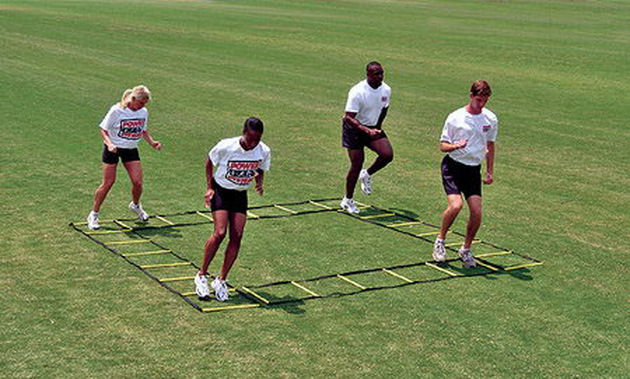For the purpose of this article, we will just look at speed/agility in invasion sports (e.g. rugby, football, basketball). However, some of these principles are transferable to other sports such as racquet sports. Invasion sports can be defined as opposing teams attempting to invade their opponent’s territory to enhance scoring opportunities [6]. Attacking meaning there is a forward progression to score and defending meaning protecting goals and trying to win possession [5]. In Part 1 of this series, I will cover what agility really is and the technical differences between unplanned and pre-planned agility. In Part 2, I will cover the cognitive differences between unplanned and pre-planned agility, the difference between attacking and defending agility and cover three different stepping techniques. Part 3 will give an overview of the physical aspects of agility and how to train to develop all agility traits. Finally, Part 4 will cover training for short sprint speed, the importance of horizontal force & power and why the speed/agility ladder is not a great tool for doing so.
 If you have been involved or spectate invasion sports, I’m sure you have seen or used the speed/agility ladder. The argument for using a ladder to improve agility is that it – improves footwork, improves co-ordination and improves the ability to change direction and therefore improves movement during game situations. However, the argument against using a ladder for agility is that – Agility is reactive in nature. It involves rapidly changing direction (violent deceleration and acceleration) while reacting to a stimulus (usually an opponent).
If you have been involved or spectate invasion sports, I’m sure you have seen or used the speed/agility ladder. The argument for using a ladder to improve agility is that it – improves footwork, improves co-ordination and improves the ability to change direction and therefore improves movement during game situations. However, the argument against using a ladder for agility is that – Agility is reactive in nature. It involves rapidly changing direction (violent deceleration and acceleration) while reacting to a stimulus (usually an opponent).
Agility is defined as “a rapid whole body movement with change of velocity or direction in response to a stimulus” [3]. Agility can be defined as an “open” skill due to the reactive nature. However, many people train agility as a “closed” skill where change of direction is pre-planned around obstacles such as poles, cones, lines and ladders. This “closed” skill is also known as change of direction speed (CODS). It is important to note that this “closed” skill rarely occurs in invasion sports and is most notably used in sports such as cricket and baseball (running between wickets or around bases).
Technical
Agility can be broken down into 3 different facets, cognitive, physical and technical [6]. The ladder or obstacles (cones, poles) are often used to develop the technical aspect of agility. These being feet placement, adjustment of steps to accelerate and decelerate and body lean and posture. It has been shown that pre planned side steps result in; greater lateral foot placement, greater lateral movement speed, increased hip abduction, greater forward foot displacement while showing lower knee joint angles and lesser forces through the knee than unplanned side stepping [1,2,4].
The study by Wheeler & Sayer [4] demonstrates and explains the technical differences between pre and unplanned side steps well. The researchers found significant differences in lateral movement speed and foot position between unplanned and pre-planned side stepping. Pre-planned side stepping conditions demonstrated greater lateral movement speed and greater forward displacement of the foot compared to unplanned side stepping. The greater lateral movement speed in the pre-planned side step indicates that movement was directed towards the intended direction change. The greater forward displacement of the foot in the pre-planned side step may have been due to the lack of reactive stimulus. The unpredictable nature of the unplanned side step may benefit from having the foot closer to the centre of mass making movement in either direction easier. This research demonstrates a decision making element limits lateral movement speed during a side step and therefore, creates a technically different movement as foot placement patterns were different between unplanned and pre-planned side steps.

A good example of George North initiating the turn at initial contact rather than taking full weight acceptance on his right leg. Also note, head, eye and body position.
Houck et al., [2] also showed greater lateral foot placement and therefore greater hip abduction (away from the midline of the body) during planned vs unplanned side stepping. The authors also noted initial knee adduction (towards the midline of the body) moments during planned side stepping suggesting during early stance, movement of the centre of mass (COM) is initiated toward the stance foot. However, during unplanned side stepping, knee moment was towards abduction indicating an immediate response to redirect the COM away from the stance foot. Why is this important? According to the authors, these results suggest during the planned side step, the subjects completed weight acceptance (weight fully transferred to stance foot) then executed the turn. In contrast, during the unplanned side step, the subjects attempted to initiate the turn at initial contact. This research again demonstrates the technical differences between unplanned and pre-planned side steps.
When it comes to ladder drills, they do not replicate the technical aspects of agility as each of these 3 technical aspects are preparing for a sharp rapid change in velocity in response to a sport specific stimulus. Based on the above research, we know using pre-planned agility movements technically are completely different movements to an unplanned agility manoeuvre. Running your feet quickly through a ladder whether it be forwards or laterally, does not provide the same stimulus as preparing and performing a rapid step. The footwork and body posture do not match. Furthermore, most ladder drills do not give you the opportunity to rapidly accelerate and decelerate. COM remains centred during a ladder drill while a side step will involve shifitng COM in the desired direction. When using pre planned obstacle drills, athletes will often get into awkward body positions to manoeuvre around poles or cones. You also only give the athlete one side stepping option where teaching the athlete a repertoire of side steps allows the athlete multiple options he/she can draw from to solve different situations (this will be discussed further under the cognitive segment in part 2).
Part 2 will detail an overview of the cognitive aspects of agility.
